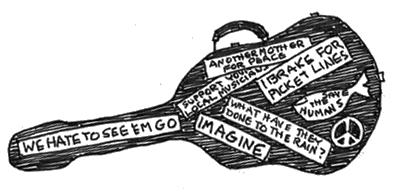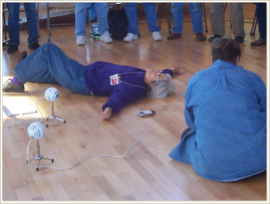


Monday:
I’m
sitting out in the back yard on a perfect spring day, still a little
high from the concert last night. We had a good turnout in numbers, and
excellent in friendliness and participation, a super audience to play
to. People who come to all our concerts and friends who had never heard
me perform. Rina from counseling at Camp Kilowana in 1953 and 1954,
folks from Threshold Choir, WoMaMu,
Freedom Song Network, from the memoir group I’m in and even from the
writing class I’m taking. A gardening teacher was there and is taking
our new song, “Every Third Bite” back to his students who are planting a
pollination garden at their inner-city school.
Rosalie
Sorrels was at the concert, in town to record some of Bruce Phillips’
songs for a new album. She wrote the liner notes for the
Smithsonian/Folkways compilation CD, Malvina Reynolds: Ear to the Ground and has her own CD of Malvina songs, No Closing Chord.
Betsy Rose was there and told us they have been singing “It Isn’t Nice”
in front of the Marine Recruitment office in Berkeley with new verses
for the occasion.
Seemed
like everybody had a good time. Judy and I certainly did. I got the
giggles, which I rarely do on stage, and had a hard time recovering. We
fumbled around some, doing songs we hadn’t done or hadn’t done in a long
time, but everybody was good-natured about it. And of course we felt
that we were in good hands at the Freight and Salvage. They have a good
sound system and good folks running the place. They arranged a table
where Susan Wengraf could show her film Malvina Reynolds: Love It Like a Fool
on her laptop during intermission. She sold all nine copies she
brought, and took orders. You can order it yourself from Susan at 1404
LeRoy Ave. Berkeley, CA 94708, email Loveitlikeafool@comcast.net. We sang a couple of songs from Omni’s new re-issue, Malvina Reynolds Sings the Truth,
and sold all our copies of that. One of the songs seemed especiallly
pertinent right now, with folks saying they’re surprised and offended by
Obama’s preacher’s anger with America’s racial injustice.
What’s Going On Down There
Words and music by Malvina Reynolds; © 1964 Schroder Music Company, renewed 1992.
Chorus:
Nobody knows about,
Nobody knows about,
What's goin' on down there,
Who's gonna tell about,
Who's gonna tell about,
What's goin' on down there.
Nobody knows about,
Nobody knows about,
What's goin' on down there,
Who's gonna tell about,
Who's gonna tell about,
What's goin' on down there.
They dragged the Mississippi for the three lost men,*
They came up with other guys, eight, nine, ten,
And threw them back again, Oh,
They came up with other guys, eight, nine, ten,
And threw them back again, Oh,
(Chorus)
You try to register like the constitution said,
They take away your job and they take away your bread;
You might as well be dead, Oh,
They take away your job and they take away your bread;
You might as well be dead, Oh,
(Chorus)
They throw you into jail all covered with blood,
F.B.I. man won't do you any good;
He also wears the hood, Oh,
F.B.I. man won't do you any good;
He also wears the hood, Oh,
(Chorus)
You stand up like a man and they cut you in two,
The killer goes to trial, but what good does it do?
He's on the jury, too, Oh,
The killer goes to trial, but what good does it do?
He's on the jury, too, Oh,
(Chorus)
The newspaper pages have nothing to say,
They either tell lies or they hide it all away,
Day after day after day, Oh,
They either tell lies or they hide it all away,
Day after day after day, Oh,
(Chorus)
We sing you this song so you know what's true,
And you've got to take the story everywhere you go,
Because it's up to you, Oh,
And you've got to take the story everywhere you go,
Because it's up to you, Oh,
(Chorus)
When I was at SF State College in 1963, I heard a lecture by semanticist (and, later, Republican senator) S. I. Hayakawa
about racism. He talked about the difference between the Japanese and
the Black experience in America. Japanese immigrants were able to hang
on to the culture and ethical system they brought with them, leaving it
to their US-born children to assimilate. Slaves speaking the same
language were deliberately sent to different plantations so they could
not conspire in a language unknown to their owners. Thus they had to
adopt English as their only language and lost much of their culture and
traditions. I remembered noticing, when I was in Brazil, the large role
African religions still played there. For a class at SF State I wrote a
paper on the differences between the two countries. For one thing, the
policy in Brazil was to keep language groups together but encourage
slaves from one tribe to inform on slaves from another tribe. This was
“divide and conquer” in a different form, probably just as effective
from the owners’ standpoint, but it preserved more of the African
cultures, giving Afro-Brazilians a better starting point even though
they had also been slaves. After emancipation, owners (not of slaves but
of farms and factories) used “divide and conquer” to beat down unions,
adding no little to the climate of racism my generation grew up with.
Last
Wednesday evening we went to Berkeley’s civic center park for a
commemoration of the fifth anniversary of the US attack on Iraq. We knew
there would be a labyrinth made of candelarias, but didn’t expect it to
be in the form of a peace symbol. One of the organizers had come across
a book about labyrinths and figured out how to do it. I’d say there
were about a hundred and fifty people of all ages walking the labyrinth,
most carrying candles and singing “We Shall Overcome.” Beautiful and
moving as dusk turned to night. We saw a few friends and neighbors, but
mostly strangers, and that’s good.
©2008 by Nancy Schimmel
Here’s
me at WoMaMu, recording a song with my MacBook and my cute new SnowBall
mike, which appears to be making friends with Amy’s SnowBall, even
though hers is attached to a PC.
Tuesday, March 25, 2008


MUSIC CAMP, VIGIL, CONCERT






